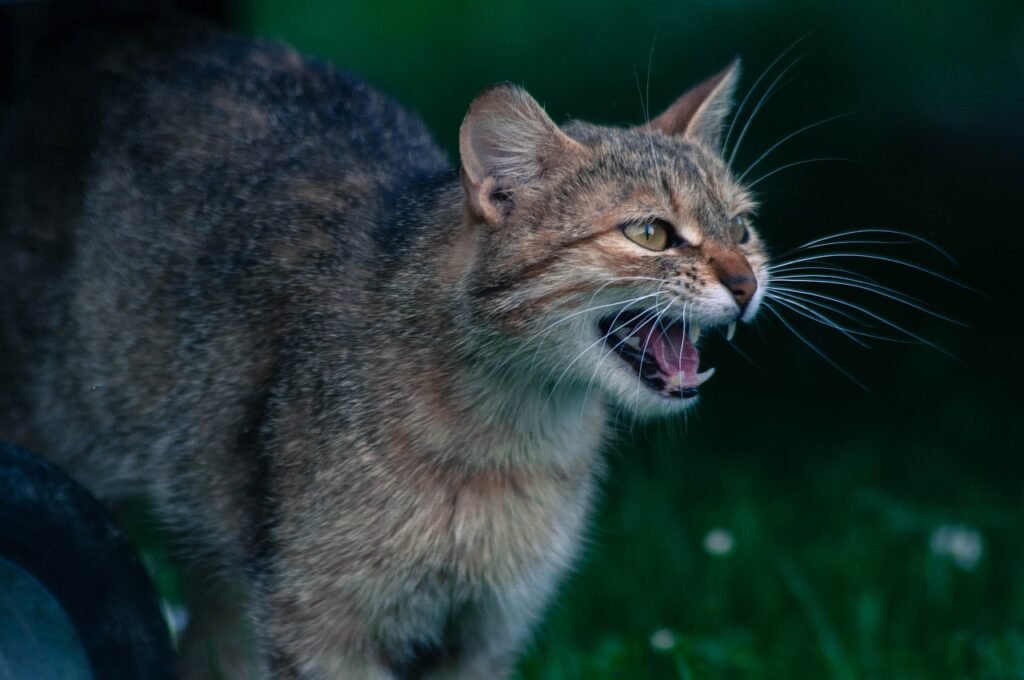Understanding Cat Behavior: Do They Know When They Misbehave? Last Updated on 22 Jan 2025, Care Kitties As cat owners we wonder …
How to Manage Aggressive Cats Effectively?
Aggression by cats is often troublesome for the owner, cat and the other cats in the house. Cat bites and scratches can cause a lot of damage to people and other cats too. So handling aggressive cats is very important, and it needs to be done as calmly and early as possible. The whole process can take a lot of time. Delaying it will only make it worse over time. So in this article, we will provide a comprehensive guide on how to handle aggressive cats.
Note: If your cats fight with each other and cannot stand against each other, instead of this article read this article of ours.
Understanding cat aggression
The aggression seen in cats primarily has its roots in fear, territorial issues, redirected aggression or even pain. Here’s a closer look at these causes:Here’s a closer look at these causes:
- Fear: If a cat feels threatened or cornered, then it will turn into an aggressive feline. This type of aggression is mostly secondary and defensive in nature.
- Territorial: Cats and other animals, too, are known to be very possessive about certain areas. They may get violent if there is a perception that another animal or a person is trespassing in their space.
- Redirected Aggression: This lights up when a cat is irritated, perhaps by a bird outside the window and out of reach, and may take out its anger on a human being or another cat.
- Pain: If a usually friendly cat starts biting or hissing at someone, that cat could be in pain. Any behavioural changes must be taken to a veterinarian to ensure medical problems are not influencing the situation.
Understanding the Stages of Aggression
Awareness of your cat’s signals is important because the first signs of aggression are often displayed through the body language of your pet. You cannot control the cat’s aggression if you do not understand if the cat is angry or not. Cats do not just immediately attack. They show it through their body language before attacking. So understanding this is very important.
- Ears: When a cat’s ears are swivelled backward or pressed close to its head, it may indicate that the cat is unfriendly or in a threatening position.
- Eyes: Anxiety, tension or even aggressiveness are also telltale signs, as observed by the participants since the pupils of the eyes were dilated or the individuals were staring fixedly. Squinting or turning the eyes away can be a sign of learning, and swallowing is also a sign of yielding.
- Body Posture: A cat that has arched its back, stands on its hind legs with the fur raised, and has its tail tucked means that it will turn to attack if provoked.
- Tail: Sometimes, wagging or moving from side to side excessively as a tail shows that the cat is annoyed or provoked. A cat whose tail is standing up straight is likely to be scared and has adopted the posture to make it look as big as possible.
- Hissing or Growling: Meows or purring make quite low-pitched sounds, and if the cat is angry, it will be hissing, growling, and even spitting.
Early days of a kitten or cat
Like humans, the habits developed in childhood remain with cats for a very long time. That is why it is very important for cat owners to make sure the early days of the cat are not aggressive. I have a friend whose cat name is Dynamo. He adopted the cat when the cat was 1.5–2 months old. After the cat was brought on, they took care of the cat-like their own child. I took care of it, fed it, and kept a separate space for it. But one thing they did wrong was that they let the cat bite them and attack them. They did not try to restrain the aggressive behavior of the cat. They let the cat be what it needed to be. It created a huge mess because, till now, the cat has been very aggressive, and it is much tougher for my friend to make the cat less aggressive. But if they had stopped it at an early age, the cat would not be aggressive now. So make sure that if the cat is aggressive, stop it in the early days. Any kind of aggression should be dealt with patiently and appropriately.
Making the Environment Safe and Serene
It has also been found that when the environment of a cat is secured, the aggression level of the cat can be minimized to a great extent. Here are some ways to create a safe space for your cat:
- Provide Hideaways: Make sure your cat has some places it can go when it wants some peace and quiet and also when it wants to feel safe and free from intruders. Higher locations, nests, and having one’s own corner may be helpful for decreasing anxious states.
- Maintain a Routine: Cats love schedules, and this is why, in the wild, the life of a cat is oriented towards the night. Training your child to eat, play, and nap at the same time each day can be calming for them.
- Reduce Stressors: There are some factors within the cat’s environment that could lead to stress, and these must be avoided or reduced as much as possible; for example, noise, other animals, etc.
Avoid Punishment
In the case of an aggressive cat, it is completely unadvisable to take punitive action, as this can only worsen the extent of the behavior. Instead, focus on positive reinforcement.
- Reward Calm Behavior: Praise, pet and offer treats to your cat when it is in a calm and relaxed state.
- Use Gentle Redirection: If your cat starts growling, hissing, or swishing its tail in circles around its face or pawing at something, try to move the cat and the source of its aggression to another room or distract the cat by shaking a toy.
Utilize Calming Products
Several products can help reduce stress and aggression in cats:
- Feliway: This is the synthetic pheromone that imitates the calming facial pheromones secreted by cats. It comes in a dropper or atomizer bottle; hence, it can either be sprayed or dipped.
- Calming Collars: These collars emit the pheromones or the aroma of the herbs, so as to lessen anxiety among them.
- Supplements: As mentioned, there are types of supplements that have contents such as L-theanine that contribute to relaxation. But take vet suggestions and advice before using any kind of supplement.
Gradual Desensitisation
If your cat’s aggression is triggered by specific stimuli (like the vacuum cleaner or a new pet), gradual desensitization can help.
- Start Slowly: First, you should introduce the cat to the stimulus from a distance where your cat will not show any reaction.
- Reward Calm Behavior: Whenever your cat remains calm, you must give it a treat or even pet it.
- Reduce the distance. Gradually: Gradually make the distances between the cat and the trigger smaller until the cat completely relaxes, and again, give treats.
Behavioral Training and Play
Regular play sessions can help channel your cat’s energy in a positive way.Regular play sessions can help channel your cat’s energy in a positive way.
- Interactive Toys: Cats are known to be hunters; therefore, you should make use of toys that mimic the situation, such as feather wands or the laser pointer.
- Scheduled Playtime: They can spend a certain amount of time in a day playing in a social, interactive way so that the aggression that builds up during the day can be eased off.
Seek professional help
If your aggression is serious or continuous, the cat should be taken to a vet or a feline behaviorist. They can give specific recommendations; in some cases, they might recommend behavioral therapy or medication.
Tips for owners
Here are some additional tips to help manage your cat’s aggression:Here are some additional tips to help manage your cat’s aggression:
- Be patient: Each cat learns in their own time. So being patient and trying to make your cat less aggressive
- Stay calm: Your cat understands everything that you say and even feels the same way you do. Calmness will also help the cat to remain calm, since animals sense our body and mental status.
- Learn to Read Body Language: It is therefore important that you read the body signs of your cat and check on them early before the aggression rises to another level.
- Avoid rough play: Tugging with your cat at around this age should be done roughly to help him develop aggressive behavior. No rough-housing or ‘tugging on the ears and tails’ kind of interaction.
Related Articles
Harness Training A Cat: An Eight-Step Guide Last Updated on 15 July 2024, Care Kitties We want to keep our cats safe …
Places that help you bond with your cat Last Updated on 09 July 2024, Care Kitties It is necessary to take cats …
Top 11 Qualities that make you the Best Cat Parent Last Updated on 26 May 2024, Care Kitties Cats are adorable and …
Litter Training 101: Essentials for New and Experienced Cat Parents Last Updated on 20 May 2024, Care Kitties From birth, cats and …
Adopt, Don’t Shop: The Advantages of Pet Adoption Last Updated on 19 May 2024, Care Kitties We all want to have a …







